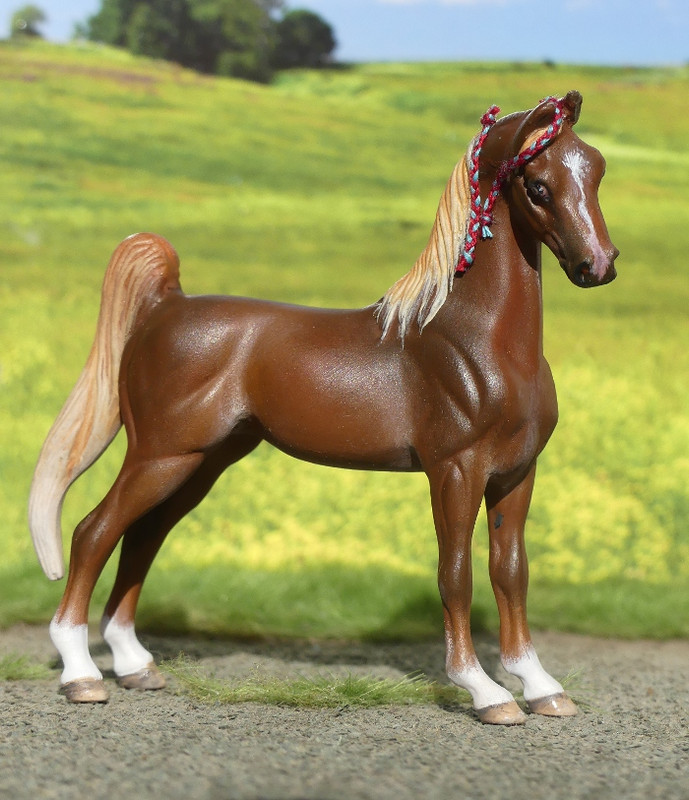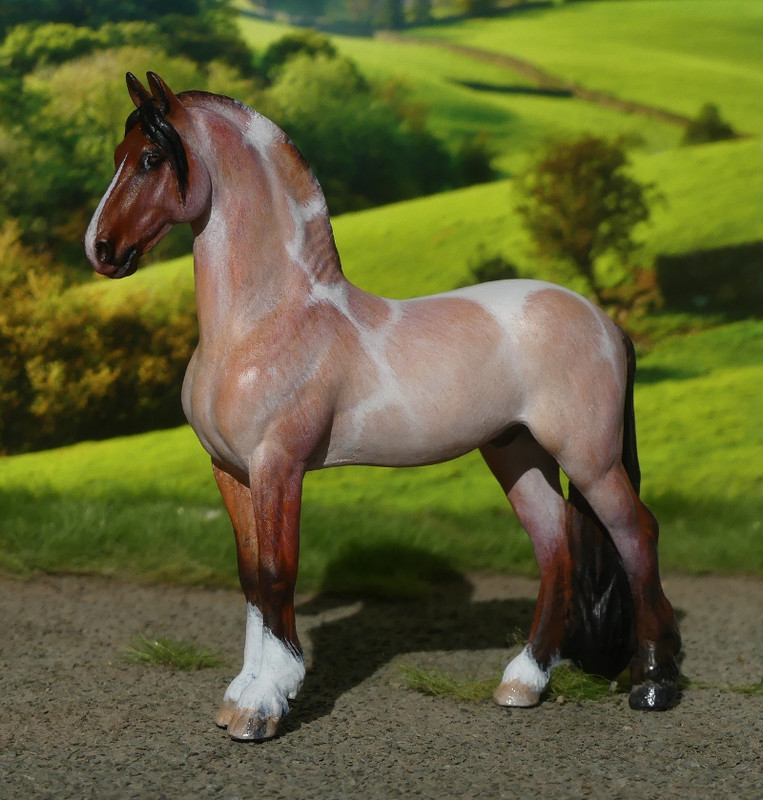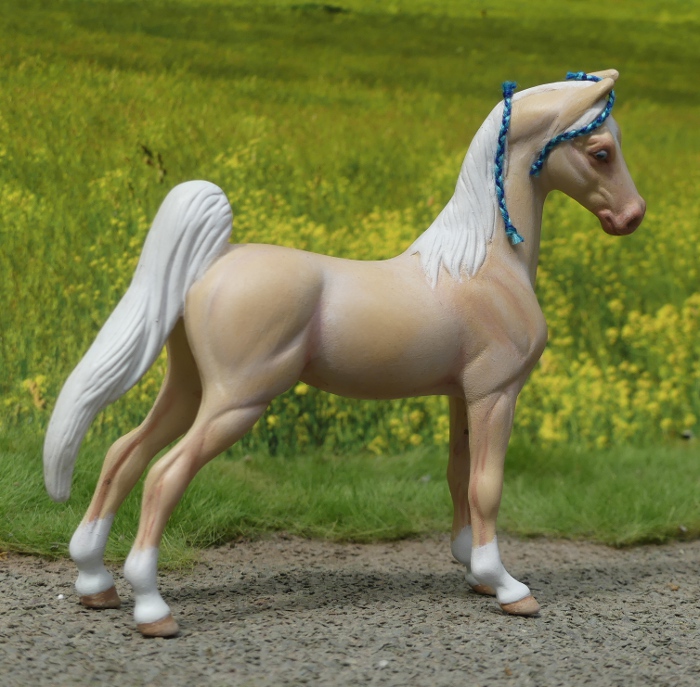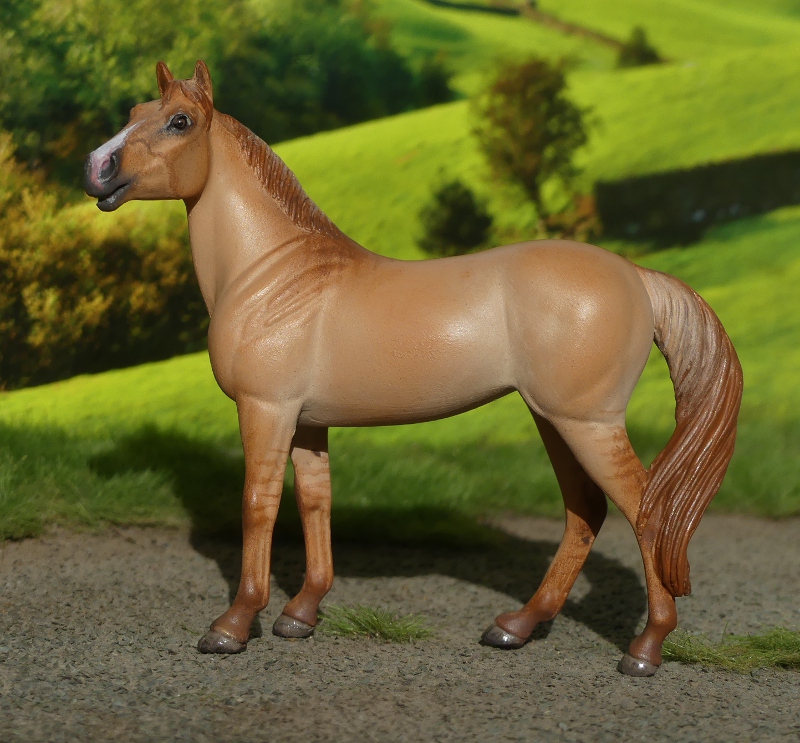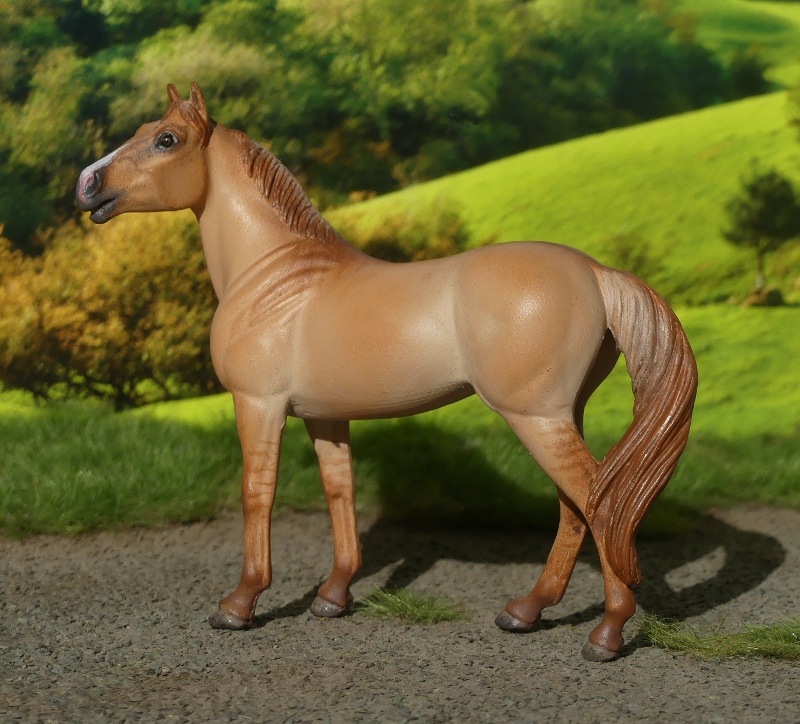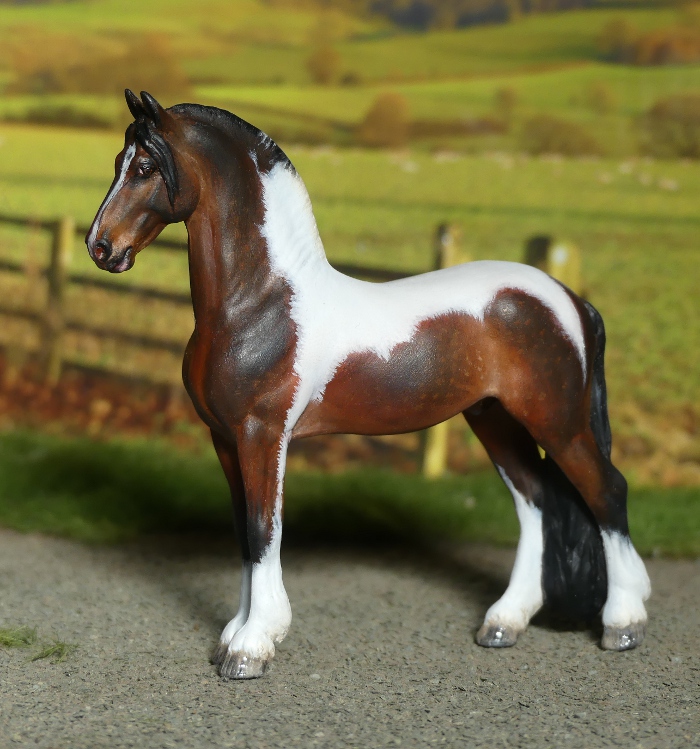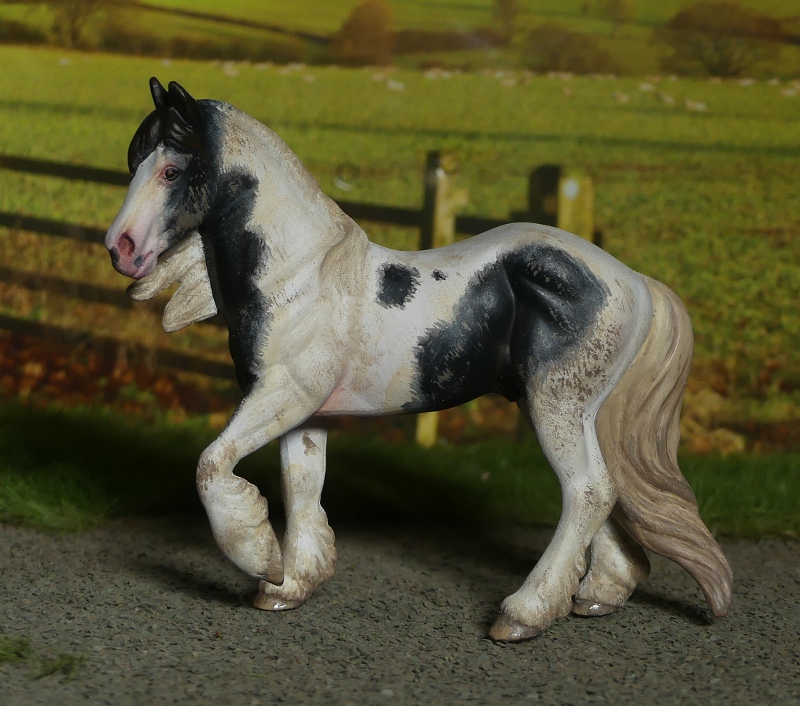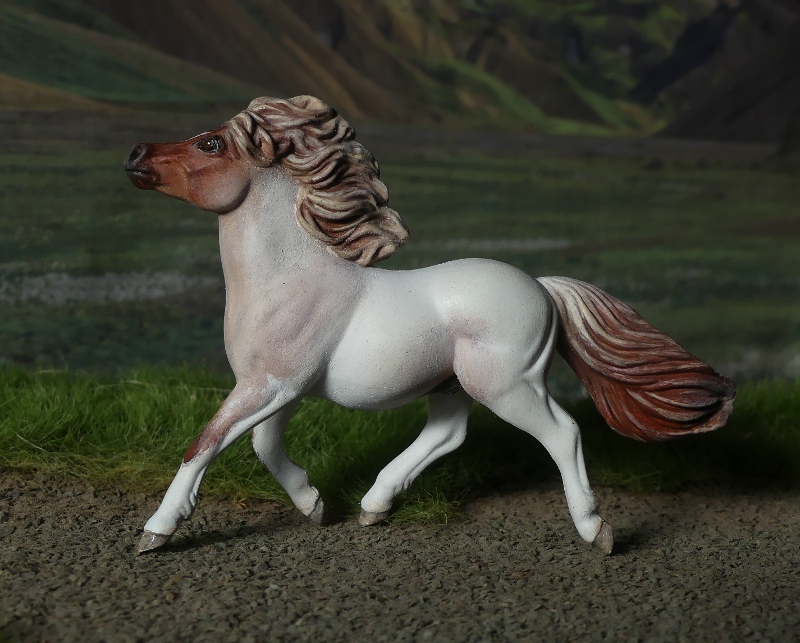Let me start by explaining I haven't been suddenly incredibly productive over a couple of days and created all these customs in one big batch - it's more a case of getting myself ridiculously left behind in compiling blog posts, so there was an ever-growing waiting list of painted and photographed horses ready to be shown here, and now I'm making them all share one big post to catch up!
The first one, you could say, came to me in a dream!
Normally, any model-related dreams seem to be about finding models for sale somewhere and either not being able to buy them, not being able to carry as many as I want to take home, or somehow managing to go through with the purchase then being mildly disappointed to wake up and realise I haven't added those ones to my collection after all, hahah! But this time, the dream was about painting : I picked out a pearly blue unicorn on the Breyer Stablemate walking thoroughbred, which was exactly the one I really did have in my body box, and painted it to match this reference photo. And in my dream, it turned out really, really nicely, just like the picture, a very striking little horse with super-flashy markings.
So I decided this meant I needed to make it happen in real life!
I found a photo of the same horse from the other side, then picked out the Stablemate from the body box - a very tricky pattern to match, eeek!
The mould looks much better without the unicorn horn, and it's not too bad for the Akhal-Teke breed either. Despite being sculpted as a Thoroughbred, it's very much the extreme end of the long-and-lean variety (many TBs these days are either much more compact and muscular as sprint distances are most popular, or else more chunky and solid-looking if they're jumps-bred to be tough and sound), so it gets away with being re-purposed as a 'Teke without much work. All I did was carve off the mane and forelock, and take a bit of the thickness out of the tail so it's more tapered toward the end.
Something about his attitude also helps capture the Akhal-Teke breed, I've added in a line of eye-white like he's giving us a bit of a wild look. But none of my lush leafy green backdrops look remotely like the middle-eastern homelands of this breed, so rather than post him in front of something inappropriately British-looking I've used a plain fence which could be anywhere, hah!
Unfortunately I haven't been able to find out the name of the real horse which inspired him, so I've picked a name myself and called him Menekli, which means 'spotted' or 'colourful' depending on which Turkmen translator I run it through - either way is very fitting for his wild splashy pattern!
I think I'd like to paint more of this mould in Akhal-Teke coat colours, there's nothing else in the Stablemate range which would be a better fit, and I doubt there will be unless they ever decide to shrink down the large scale Altynai/Adamek sculpt to mini size!
So I'm plotting this one in perlino, and golden palomino, and metallic sooty buckskin, whenever I eventually get my hands on more, of course! At the moment they're only available as unicorns in painting kits, in horse/unicorn family sets, or annoyingly in those lucky-dip blind bags where you've far more chance of getting a different mould, so it's a case of fingers crossed for a normal 'single' release at some point soon, so they're easier to stock up on for the body box!
Next, a Stablemate 'Prince charming' I fished out of the body box and gave the colour I'd had in mind ever since I ordered it - a second Orlov Trotter for my herd.
The first one I painted was a very dark dappled grey, but in researching her I'd seen quite a lot of photos showing older horses, a few years further along in the greying process, with the remains of dapples shading into dark legs. And they looked very striking, so I decided back then that next time I got one of this mould (known as Prince Charming, but actually a mare) that's what it would be set aside for.
I used an off-white base coat, lightly shaded just to give the hints of dark skin showing through to capture that typical faint greyishness which remains even in a white horse, then added all the dappling and leg shading using pencil.
I've tried paint over pencilled dappled to shade the legs before, and it seems to somehow not take properly, like the pencil graphite layer is water-repellent and argues with my water-based paints, so this time I just went with lots and lots of determined scribbling to fill in the legs with the pencil too.
The reason she has white socks on all four feet is so I didn't have to scribble all the way down, it's hard to get proper coverage in the tendon grooves so I image the tricky bits behind the ankle joints would be even more inaccessible!
I've named her Strekoza, which means dragonfly, because my first one is Babochka, or butterfly. If I ever paint up any more of this beed, I'm going to be googling the words for bee or hoverfly or moth, to keep the theme going!
The Django mould was sculpted as a Friesian, in fact it's alternative name is the Standing Friesian. But Breyer have been selling him in lots of incorrect colours for that breed - so far we've had just one regular run (if you can call that dratted blind bag system a 'regular' run when you can't decide which model you're getting), a spotted dun. There's also been a pinto and a palomino as club-member-only exclusives, a Breyerfest grey, a bay only sold in US Walmart shops, and a couple of clear/metallic decorator colours.
So we've had the mould since 2016, and they still haven't released it in black?!
I got fed up waiting for them to get round it, and painted my own black one!
Black might sound like a really easy colour to paint, and it's certainly easier than fiddly colours like roany appaloosas or intricate pintos, but it's getting some sort of depth and warmth to it which is the tricky part. I used some chocolate brown in the mix for the belly and flanks, and a hint of beigey grey dotted into the black paint to give the face some shading where the skin would show.
The main body of the horse is polished with a bit of fleece to give the paint finish a natural shine, then the mane and tail I gave a coat of varnish followed by a very thin wash of dilute black just to take the edge off the gloss and soften it slightly. The hooves have two coats of clear nail varnish to capture the look of blacked and oiled hooves, the traditional turnout fashion for Friesians.

This angle shows the brilliant upright alert posture, so typical of the breed. I do like Breyer's trotting Friesian mould, but I prefer this one - the proportions and pose are perfect, the head is more detailed, and the sculpting style is more my taste too.
I've named him Adarik, cos my G2 Friesian is Alaric and matching names do amuse me!
Next, my first ever custom on this mould, and my first ever custom of this breed...

Introducing Harecroft Shakespeare, the Cleveland Bay.
This mould was sculpted as an Irish Draft (again, we haven't had a regular run in any right colour for the breed - only a spotted one!) but ever since it was first announced, I thought it would be perfect for a Cleveland Bay. The roman nose, the chunky legs, the big deep rounded body, and the kind placid look of him.
Bay is a fairly straightforward colour to paint, I went for a dark shade with less of the pale highlights than I'd usually put on, this one has more reddish undertones but all toned down with plenty of black. The only issue I had was the spots from the factory paintwork - being slightly thick they showed through my experimental first layer of paint, so I had to scratch them all off with a scalpel blade and start again on a smoothed surface!
At some point I might do another Cleveland in a lighter bay, they do come in many varied shades despite being a single-colour breed, but this was the colour of the one I rode in lessons for a little while, so it's how I always think of them.
She was an ex hunter and rather difficult for a riding school, leapt everything as though it was a five foot wide hedge, which took some getting used to, as a lightweight kid who'd only ever jumped low heights with ponies and cobs! I also took her to a gymkhana once and got scolded for 'bombing about on that great big horse' cos I had very little control and she was enjoying herself a bit too much. But we came home with a string of five rosettes (which I still have, with her name written on the back), so we did ok despite me being little more than a passenger!
I credit many different horses with teaching me different aspects of horsemanship and riding over the years - she was the one who taught me the art of pretending I really did want to go that fast!
Another first for me, though not a new mould it's the first time I've painted one as an Altér Real, a strain developed and preserved at the Portuguese royal stud. They're a little bit deeper in the neck and chest than the usual modern Lusitano's build, due to crossing with Andalusian and Carthusian stallions to bring the breed back to it's old type after they'd been spoilt with too much TB and Arabian crossing during Napoleon's era. So their typical shape is rather like a halfway point between the Lusitano and Andalusian, meaning I can use an Andalusian sculpt to represent one.
They're a breed which is almost entirely bay in colour, but through various shades from deep dark-chocolate brown right through to a gingery tan colour, always with black points. I picked a shade I don't paint very often, a medium bright bay, with just a little bit of dappling and shading to give him some depth.
I'm not sure which photo I like best as his main shot! I was really pleased I'd got a background of the right country, most of them are just fields or fenced paddocks with some green countryside behind, but when I searched through the stack of pictures I found this one, which shows the landscape around the stud where they're bred.
I've picked a name from a real pedigree, he's called Maravilha (but that's Harecroft Maravilha AR, to give him his full title with my show prefix and his breed suffix).
Bright Lights, my first custom on the Missouri Fox Trotter mould. It's not a breed I know a great deal about, this is only my third model of one (after the CollectA chestnut mare, and the grey on this Stablemates mould). I looked up colours and while solid coats are the most common, there was also a really lovely example of a purebred in this bay pinto with quite subtle pinto patterning - just very high socks, a flash of white on the neck, and a mostly white tail.

Yet another first, this time my first ever Pony of the Americas custom, though the sculpt is one I've painted before. The 'POA' was developed by breeding small Appaloosas with Shetlands, to get the Pony size and tough nature combined with the flashy colour, they're quite a new breed compared to either of their contributing halves, but seem to be popular and much liked.
They come in all variations of appaloosa pattern, but leopard and near-leopard seem to be the commonest, and I paint more roany blanket patterns normally, so I decided to go for full-body spotting this time! His base colour is bay, so the spots vary in colour from light brown to dark brown to black.

Adding in the spots is always the most fun part of the process, making up a pattern and filling it in til there's just the right amount. Of course the number of spots any one horse will have varies hugely, from just a couple to hundred upon hundred, so that leaves me plenty of leeway for making up a realistic design!
Another of the 70th Anniversary moulds, this is the Fighting Stallion - no breed given but I think he's usually regarded as a Mustang. I've called mine Daredevil. As I said before, the glossy finish had me a bit worried that my paint wouldn't stick or cover as well as usual, but it was just fine.
I've got some white paint which is rapidly trying to set solid, so I'm trying to use it up by doing horses which have layers of solid white as base coat and then smaller markings like patches or spots added, rather than applying just a bit of white over a painted colour! That does make it tricky to get the patches on smoothly, the result always looks a little bit water-colour and tends toward messiness.
This is Harecroft Reckless, yet another tobiano cob on the mini Vanner mould. I have about eight of these to paint so there's bound to be a lot of different pintos!

I decided to do a dun/buckskin base colour this time, to use my golden shades of paint - not quite sure which he'd end up as I went along, in the end I settled on buckskin so didn't give him a dorsal stripe or leg barring.
The last painted custom is based on a fascinating reference picture I found online, here. I've tried to figure out what colour that horse is, genetically speaking, and the best I can come up with is that he's a sooty buckskin, going grey, but then also clipped, which really changes the look of the coat by taking off the coloured tips of the hairs. It especially messes with the look of dapples and greying, both of which this horse seems to have, so it's no wonder he's ended up all blotchy and mottled!
It was a very hard colour to replicate, and I think mine does have less contrast between the dark and light because I was scared of spoiling it and stopped at a point which looked reasonably neat and nice, rather than adding more layers and risking ruining it into a paintstrokey blobby bit of impressionist art!
He looks quite a bit darker in the shade, but when it's such a weird colour anyway I don't think any lighting would really flatter it - I doubt I'll ever enter this one in photo shows cos 'Sooty buckskin going grey but also clipped' isn't a colour there's ever a class for, and judges might just take one look and think I'm a messy painter!
I haven't chosen him a name yet, but the mould was sculpted as an Irish Draft, and as both buckskin and grey are found in that breed, there's no need to change it. The original horse in the reference picture has 'Galway' in his name, so I suspect he's either pure ID or at least a partbred one and from Ireland.
And finally (phew!), an attempt at etching, taking the factory paint off with a knife point or scraper, leaving the original colour behind only where you want it - usually in a pinto or appaloosa pattern, as that looks more dramatically different than just extending the white socks or giving it a new face marking.
It's very fiddly and time-consuming (getting both sides of this small foal mould to the amount I wanted took nearly two hours!) but looks quite fun when finished, and it made a change from painting.
There is a little bit of my own paint applied here, to give the hooves some colour and add the pink speckling on the face, but other than that it's just white plastic revealed by scratching off the black paint finish.






























